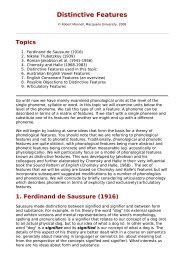PHONETICS AND PHONOLOGY COARTICULATION SOLUTION ...
PHONETICS AND PHONOLOGY COARTICULATION SOLUTION ...
PHONETICS AND PHONOLOGY COARTICULATION SOLUTION ...
Create successful ePaper yourself
Turn your PDF publications into a flip-book with our unique Google optimized e-Paper software.
<strong>PHONETICS</strong> <strong>AND</strong> <strong>PHONOLOGY</strong><br />
<strong>COARTICULATION</strong><br />
<strong>SOLUTION</strong><br />
Activities: To be completed in groups of two or three<br />
1a. Carefully produce the following pairs of words and attend to the initial stop<br />
consonant.<br />
“key” “caw”<br />
“kit” “caught”<br />
“keep” “cook”<br />
“kid” “could”<br />
Describe your observations with regards to modifications from the expected velar<br />
articulation. Can you explain this?<br />
The velars before front vowels are fronted to palatal and the velars before back<br />
vowels are retracted<br />
b. Examine your production of the following pairs of words attending to the place of<br />
articulation of the final consonant.<br />
“pork” “peak”<br />
“morgue” “league”<br />
“walk” “week”<br />
“look” “leak”<br />
Again describe any modifications from the expected velar articulation..<br />
The difference should not be as great in this position due to the fact that English is<br />
an anticipatory language.<br />
c. Is there greater difference between the pairs in (a) or (b)?<br />
2 a. While holding your nose to prevent air escaping, say the pairs of words below<br />
and examine the differences between the vowel phonemes in each pair.<br />
“pan” “pat”<br />
“pin” “pit”<br />
“corn” “caught”<br />
“been” “beat”<br />
Describe the difference.
You should be able to feel that the vowels preceding nasals are nasalised (you can<br />
feel the nasal resonance). You can also do this by putting your hands over your ears.<br />
b. Repeat this exercise with the following words<br />
“nat” “tan”<br />
“knit” “tin”<br />
“mark” “calm”<br />
c. How do the two conditions differ?<br />
Greater nasality for vowels before nasals than after nasals again due to anticipatory<br />
coarticulation<br />
3. Examine the articulatory processes involved in producing the final consonant<br />
cluster in the following words.<br />
“apt” “akt” “walked” “jabbed”<br />
These words contain heterorganic consonant clusters which are produced such that<br />
the closure of the first is not released until the second closure has already been<br />
created. The two sounds stops are coarticulated in the literal sense where two<br />
articulations are occurring at the same time.<br />
4. Transcribe phonetically your production of the nasals in the following words<br />
“invite” [M]<br />
“infinity” [M]<br />
“incorporate” [N]<br />
“under” [n]<br />
“canyon” [¯]<br />
“onion” [¯]<br />
Explain the variation – anticipatory coarticulation<br />
5. Examine the corpus below from Mokilese an Austronesian language of the South<br />
Pacific<br />
[pi8san] "full of leaves" [uduk] "flesh"<br />
[tu8pu88kta] "bought" [kaskas] "to throw"<br />
[pu8ko] "basket" [poki] "to strike something"<br />
[ki8sa] "we two" [pil] "water"<br />
[su88pwo] "firewood" [apid] "outrigger support"<br />
[kamq�ki8ti] "to move" [lud�uk] "to tackle"
Can you explain the voiceless variants of the vowels present in the data?<br />
Close vowels become voiceless in this language when they occur between two<br />
voiceless consonants. Note that [o] does not become voiceless in [poki] because it is<br />
a half close vowel and not a close vowel.<br />
6. The following is data from Castilian Spanish which has three nasal phonemes<br />
/m, n, �/<br />
[�a�fo�a] "amphora"<br />
[en���ia] "gum"<br />
[�an��t�es] "before"<br />
[�an�t�a] "wide"<br />
[�ba�ko] "bench"<br />
[e���uto] "dry"<br />
[n�] is interdental, [n��] is dental<br />
Explain the alternation of the nasals.<br />
This is a simple case of anticipatory coarticulation<br />
7. Hausa is described as a language with two nasal phonemes /n/ and /m/. How do<br />
you explain the presence of the following words in the language.<br />
[s��k’o] "baldness"<br />
[s��ho��] "a type of basket"<br />
[k��wa] "potash"<br />
[ŋ] is an allophone that occurs before back consonants. In these words the velar,<br />
glottal and labial-velar.<br />
8. Examine the lip gestures that occur in the following words in English.<br />
“sweep” “seep”<br />
“soon” “six”<br />
“strewn” “seven”<br />
“swoop” “super”<br />
“switch” “soothing”<br />
Can you explain why some words have lip rounding throughout and others do not?<br />
In “sweep, switch, soothing” lip rounding occurs as a result of the labial-velar /w/ and<br />
the rounded /u/ but cannot continue because rounding is inconsistent with the lip<br />
specification for [i] and [�].
“seep, six, seven” have no lip rounding at all.<br />
“soon, strewn, swoop” have lip rounding throughout as there are no sounds requiring<br />
unrounding.<br />
9. In many languages consonant place of articulation is affected by the place<br />
characteristics of following vowels such that back vowels often condition back<br />
varieties of consonants and front vowels condition more fronted varieties. There are<br />
however constraints on the degree to which such conditioning occurs in language.<br />
Examine the voiceless stop phoneme inventory of Yanyuwa below and explain why<br />
consonant to vowel coarticulation is greatly reduced in this language. The symbol for<br />
the apical post alveolar is a dot under the [t]. This is not the same as retroflex which<br />
is a sub-apical palatal.<br />
bilabial laminal apical laminal palatal velar<br />
dental post alveolar post alveolar<br />
[p] [t�] [t�] [t�] [c] [k]<br />
This language has a very complex consonant inventory which requires careful place<br />
specification inhibiting coarticulation.

















